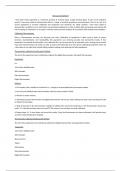Other
Unit 2B: Undertake calorimetry to study cooling curves.
- Institution
- PEARSON (PEARSON)
This is the BTEC Applied Science Unit 2B Assignment : Undertake calorimetry to study cooling curves, which was awarded a distinction . This is an example of a assignment which was awarded Distinction level, you may use it as a guide to help you achieve a distinction. Good Luck.
[Show more]



